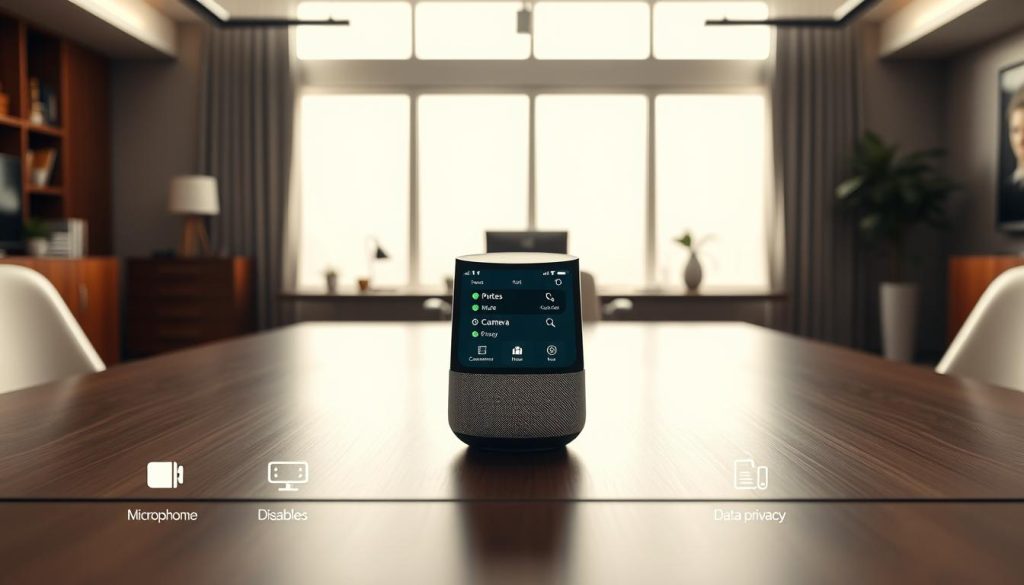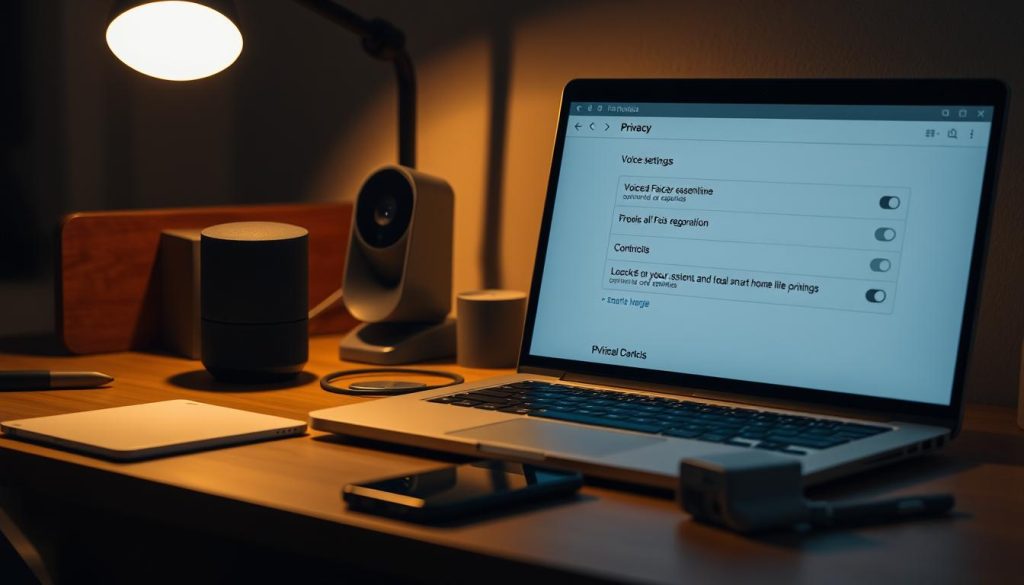Modern homes run on always-listening microphones and rising camera use. That convenience moves a lot of data through your house, often more than an average user expects. This creates clear benefits and open issues for security and trust.
Major companies collect many categories of information for assistants and services. For example, Amazon Alexa and Google Home store identifiers, location, contacts, browsing history, and audio recordings. Cloud handling can encrypt transit and sometimes rest, yet retention rules differ and mistakes have occurred.
This guide uses a practical approach. It first explains why privacy matters, then shows where data and face recognition live in the pipeline, and finally gives fast settings and daily tips that keep device function while giving the user more control.
Key Takeaways
- Always-listening mics and cameras mean more data flows through the home.
- Big platforms collect audio and metadata; check retention and deletion options.
- Wake-word detection is local until the assistant sends requests to the cloud.
- Face data is biometric and carries higher risk than passwords or tokens.
- Follow quick settings, on-device options, and app paths for immediate control.
Why privacy matters in always-listening, always-seeing smart homes
Smart speakers and cameras promise convenience while quietly expanding what your home shares. That trade-off matters because every interaction creates data that leaves rooms and enters company systems. Awareness about information flows is the first step in reducing risk.
Today’s reality: convenience vs. data exposure in the United States
Three out of four Americans use assistants, and many rely on hands-free control for daily tasks. This popularity means home devices now broadcast more information than a decade ago.
What users actually know and do: key survey stats
Survey data shows mixed sentiment: 31% have strong concerns, 27% worry sometimes, and 43% report no concern. Nearly half didn’t know assistants listen for wake words, and 68% never changed settings. Yet 77% said they would use assistants more with clearer controls.
- Company practices differ: Apple favors on-device work; Google links activity to accounts; Amazon stores transcripts until users act.
- Legal actions — including an FTC penalty — underline why users should limit stored recordings and tighten settings.
Readers will find clear steps next that cut unnecessary collection while keeping the convenience users value.
How voice recognition systems collect and process your data
A voice assistant’s path from wake cue to answer moves audio across local hardware and cloud servers.
From wake cue to cloud
The system listens locally for a wake cue. That passive mode does not send audio off the device.
Once triggered, the device shows an active indicator and records the request. The audio then travels to the cloud for heavy recognition and response generation.
After the reply, the device returns to standby.
What gets collected beyond speech
Recordings are only part of the picture. Service providers also gather device metadata, timestamps, and geolocation to personalize answers and improve accuracy.
Contextual data — accents, session patterns, and performance metrics — help refine models. Diagnostic logs may include software versions and error reports.
Storage, retention, and security
Companies typically encrypt audio in transit and often at rest. Still, servers must decrypt data to process requests.
Retention policies vary: some keep account-linked recordings until deletion, others offer auto-delete windows or anonymized samples for research.
Practical controls include deleting recordings, disabling audio saving, and adjusting wake sensitivity across all devices linked to an account.
| Stage | What is captured | Why it matters | User control |
|---|---|---|---|
| Passive listen | Wake cue detection only | Limits unnecessary upload | Adjust sensitivity |
| Active recording | Audio + timestamps | Triggers cloud processing | Mute or physical switch |
| Cloud processing | Transcripts, device info, geolocation | Enables replies and personalization | Disable audio saving; opt out of grading |
| Storage & retention | Saved recordings, anonymized samples | Impacts long-term exposure | Auto-delete windows; manual removal |
How to Maintain Privacy When Using Voice & Facial Recognition Smart Tech
Small tweaks in device menus can cut unwanted data collection in minutes.

Quick-start checklist:
- Mute microphones when rooms are idle or during private talks.
- Lower wake-word sensitivity in the app (Google Home: Device Settings > “Hey Google” sensitivity).
- Turn off continued conversation or similar modes that keep devices listening.
- Review and delete stored voice recordings from each assistant’s privacy hub.
- Opt out of human grading where an option exists and disable assistant on lock screens.
Use each assistant’s app dashboard to toggle audio saving and set auto-delete windows. Apply the same controls across phones, speakers, displays, and TVs so one device does not override the rest.
Build daily habits: mute during meetings, place devices away from high-traffic spots, and use quick cleanup phrases like “delete my last conversation” when a mistaken activation occurs.
| Action | Where | Benefit | Quick step |
|---|---|---|---|
| Mute mic | Device hardware | Stops uploads | Flip physical switch or tap mute |
| Wake sensitivity | Assistant app | Fewer false triggers | Adjust sensitivity slider |
| Delete recordings | Privacy dashboard | Reduce stored data | Set auto-delete or remove history |
| Lock-screen access | Phone & assistant settings | Limits unintended commands | Disable assistant when locked |
Lock down your voice assistants: Alexa, Google Assistant, and Siri
Small, deliberate settings changes can sharply reduce unnecessary data collection from home assistants.

Limit collection at the device level
Mute microphones when rooms are idle and lower wake-word sensitivity in each app. Turn off Continued Conversation so the assistant stops listening after each reply.
Manage recordings and reviews
Review and delete saved recordings in each app. Google users can purge activity via the Assistant Activity page or voice commands. Apple lets you remove Siri & Dictation History on iPhone. Amazon stores transcripts until you delete them; opt out of human review where possible.
Account controls and profile links
Adjust Web & App Activity on Google and disable including audio recordings. For Apple, disable Allow Siri When Locked. Check skill permissions for Amazon and limit third-party sharing.
User access and roles
Require authentication for purchases, set individual profiles, and use guest modes for visitors and kids. Restrict who can manage devices in the app.
| Action | Place | Benefit |
|---|---|---|
| Mute mic | Device hardware | Stops uploads of audio |
| Auto-delete | Account dashboard | Limits stored recordings |
| Wake sensitivity | Assistant app | Fewer false activations |
| Require auth | Device & app | Controls who accesses features |
Facial recognition, cameras, and smart locks: minimize biometric risks
A captured face is not a password: it cannot be swapped after a breach and demands stricter care.

Why biometrics are different
Biometric identifiers are permanent. If a face template leaks, you cannot change the marker like a token or password. That permanence raises long-term security and legal risks for users.
Prefer local processing over cloud
Choose products that perform recognition on the device and store templates locally. Local processing limits exposure from cloud breaches and legal requests.
“Keep biometric templates on-device and encrypted; that reduces third-party access and the chances of wide-scale compromise.”
Camera and doorbell settings
Configure zones and indicators. Use activity areas, privacy masks, and visible recording lights. When possible, enable offline or shutter modes and pick short retention windows for recordings.
| Risk | Best practice | Example | Benefit |
|---|---|---|---|
| Template breach | On-device storage + encryption | SwitchBot Lock Ultra Vision Combo (AES-128) | Less cloud exposure |
| Accidental capture | Activity zones & privacy masks | Adjust camera field of view | Limits neighbor/public footage |
| Excess footage | Event-based clips; short retention | Turn off continuous recording | Fewer stored recordings |
| Unauthorized access | Restrict enrollments; strong admin creds | Audit profiles regularly | Better access control |
Smart home case studies: privacy approaches across products
Different companies frame safety and convenience in distinct ways. This affects what information leaves your home and how easy it is for a user to control that flow.

Apple Siri
On-device processing is a core feature. Apple uses local processing when possible and assigns random identifiers rather than tying activity to an Apple ID.
Users can delete Siri & Dictation History easily, and human grading is off by default. These choices reduce long-term exposure of recorded information.
Google Assistant
Account linkage supports personalization. Google ties assistant activity to Google Accounts while encrypting data in transit and at rest.
Granular controls exist for Web & App Activity, audio inclusion, wake sensitivity, and Continued Conversation. Diligent use of these controls gives more control over stored recordings and processing.
Amazon Alexa
Recordings and transcripts are kept by default. Alexa stores audio until a user deletes it and offers opt-outs for human review.
Recent legal scrutiny and penalties have highlighted retention risks. Regular audits of the Alexa dashboard help limit unnecessary storage.
“Compare encryption norms, retention rules, and whether templates are tied to profiles — those differences change real risk.”
- Practical example: Pair an on-device-first assistant with a platform that offers granular controls for a balanced setup.
- Audit habit: Check dashboards after updates, confirm deletion settings, and verify opt-outs remain active.
Advanced protections for privacy-first homes
Layered defenses keep sensitive information where it belongs: inside your walls and under your control.
Adopt local-first devices. Pick locks and cameras that run recognition on-device and store templates locally. For example, the SwitchBot Lock Ultra Vision Combo keeps facial templates on the device with AES-128 encryption and can operate offline. That approach limits biometric data exposure and reduces cloud attack surface.
Network hygiene and account hardening
Segment your network by placing home devices on a separate SSID or VLAN. Use WPA3 when available and unique strong passwords for router and device accounts.
Enable multi-factor authentication across assistant and camera accounts. Turn on firmware auto-updates so software patches reach devices quickly and lower system risk.
When it matters most, go offline
Prefer devices with physical mute buttons, camera shutters, or no-cloud modes. These hardware controls guarantee microphones and lenses are inactive at the hardware level.
“Minimize cloud connections for the most sensitive functions and use short retention windows elsewhere.”
- Limit cloud storage for biometric and video data.
- Create guest networks and time-bound access codes for visitors.
- Keep a simple inventory of products, firmware versions, and key settings for regular reviews.
| Area | Action | Benefit |
|---|---|---|
| Device choice | Local processing + AES encryption | Less cloud exposure for biometric data |
| Network | Segmented SSID, WPA3, unique passwords | Reduces lateral movement after compromise |
| Access | MFA, password manager, app permission review | Stronger account security and limited app reach |
Conclusion
Practical control starts with understanding what information leaves your home and why it matters. Convert knowledge into action by using simple settings that cut unnecessary data while keeping key features active.
Take three quick steps: mute microphones when rooms are idle, lower wake sensitivity for better false-activation control, and disable continued conversation. Then set auto-delete windows and remove stored recordings so transcripts do not linger.
Pick platforms that match your needs: favor on-device processing and random IDs, use account-level controls for personalization, or actively manage default storage. For any face-based feature, choose products that keep templates on the device and work offline.
At the end, audit your devices today, apply the checklist, and mark a quarterly review on your calendar. Small habits now reduce long-term risk and keep your home technology working for you.

